语法--10--done,doing做状语
逻辑关系用法说明例句时间相当于 “when/while + 主语 + 谓语”,可在分词前加 when/while 强调时间1. Seeing the teacher, the students stopped talking.(看到老师时,学生们停止了说话。)2. While waiting for the bus, I checked my phone.(等公交车时,我看了手机。原因相当于 “b
·
提示:文章写完后,目录可以自动生成,如何生成可参考右边的帮助文档
文章目录
分词作状语
1.含义
“分词作状语” 是英语中非常重要的语法结构
- 用于简化句子、表达动作之间的逻辑关系(如时间、原因、条件、伴随等)。
- 分词分为现在分词(doing) 和过去分词(done) ,
- 二者作状语时的核心区别在于:现在分词doing表示主动或进行,过去分词done表示被动或完成。
回顾 :分词 (doing & done) 作定语
2.语法
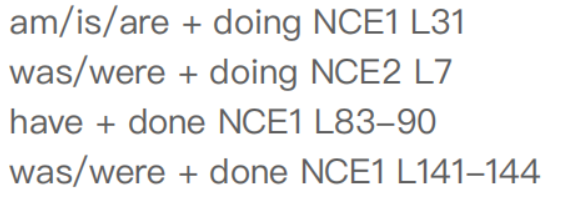
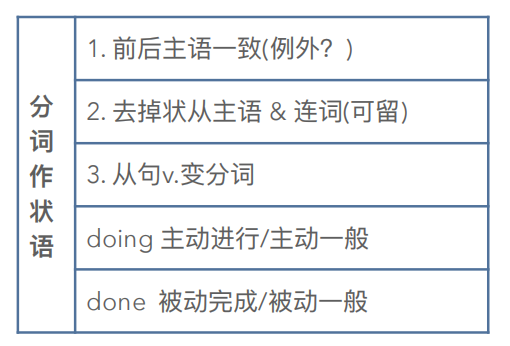
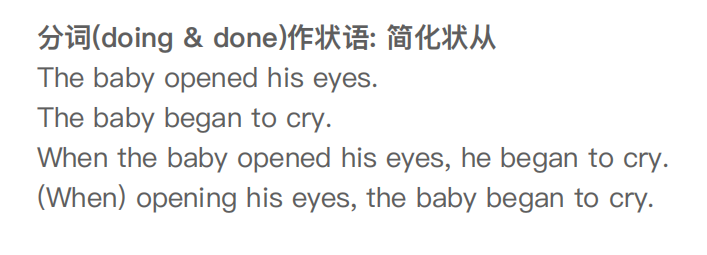
2.1 分词短语做状语









2.2 分词作状语





逻辑总结
一、核心前提:逻辑主语一致

二、现在分词(doing)作状语:表主动 / 进行
| 逻辑关系 | 用法说明 | 例句 |
|---|---|---|
| 时间 | 相当于 “when/while + 主语 + 谓语”,可在分词前加 when/while 强调时间 | 1. Seeing the teacher, the students stopped talking.(看到老师时,学生们停止了说话。)2. While waiting for the bus, I checked my phone.(等公交车时,我看了手机。) |
| 原因 | 相当于 “because/since + 主语 + 谓语”,表主句动作的原因 | 1. Being late for work, he was criticized by his boss.(因为上班迟到,他被老板批评了。)2. Not knowing her address, I couldn’t send her the gift.(因为不知道她的地址,我没法给她寄礼物。) |
| 条件 | 相当于 “if + 主语 + 谓语”,表主句动作的前提 | 1. Working hard, you will surely make progress.(如果努力学习,你一定会进步。)2. Turning right at the corner, you’ll see the bank.(在拐角处右转,你就能看到银行。) |
| 让步 | 相当于 “though/although + 主语 + 谓语”,表转折关系,可加 though | 1. Knowing the danger, he still rushed into the fire.(尽管知道危险,他还是冲进了火场。)2. Though raining heavily, we went on a picnic.(尽管雨下得很大,我们还是去野餐了。) |
| 伴随 | 表谓语动作发生时 “同时进行的另一个动作”,通常用逗号隔开 | 1. She sat on the sofa, reading a novel.(她坐在沙发上,读着一本小说。)2. He ran out of the house, shouting loudly.(他跑出房子,大声喊着。) |
| 结果 | 表谓语动作带来的 “自然结果”,通常放在主句后,无逗号(或用逗号隔开) | 1. The fire lasted for hours, destroying the entire building.(大火烧了几个小时,烧毁了整栋楼。)2. He didn’t study hard, failing the exam.(他没努力学习,结果考试不及格。) |
三、过去分词(done)作状语:表被动 / 完成
| 逻辑关系 | 用法说明 | 例句 |
|---|---|---|
| 时间 | 相当于 “when + 主语 + be + done”,可加 when | 1. Seen from the top of the mountain, the city looks beautiful.(从山顶看,这座城市很美。)2. When asked about his plan, he said he would travel.(当被问到计划时,他说要去旅行。) |
| 原因 | 相当于 “because + 主语 + be + done”,表 “因被动动作导致的结果” | 1. Surprised by the news, she couldn’t say a word.(被这个消息吓到,她一句话也说不出来。)2. Tired from work, he went to bed early.(因工作累了,他早早就睡了。) |
| 条件 | 相当于 “if + 主语 + be + done”,表 “被动条件” | 1. Given more time, we can finish the task better.(如果给更多时间,我们能把任务完成得更好。)2. Compared with last year, this year’s sales are higher.(和去年相比,今年的销量更高。) |
| 让步 | 相当于 “though + 主语 + be + done”,表 “被动转折” | 1. Beaten by the opponent, he didn’t give up.(尽管被对手打败,他没有放弃。)2. Though told to stop, he kept talking.(尽管被告知停下,他还是继续说。) |
| 伴随 | 表谓语动作发生时 “主语所处的被动状态” | 1. The teacher entered the classroom, followed by some students.(老师走进教室,后面跟着几个学生。)2. He lay on the bed, covered with a blanket.(他躺在床上,盖着一条毯子。) |
四、特殊情况:独立主格结构(逻辑主语不一致)

五、常见错误与辨析
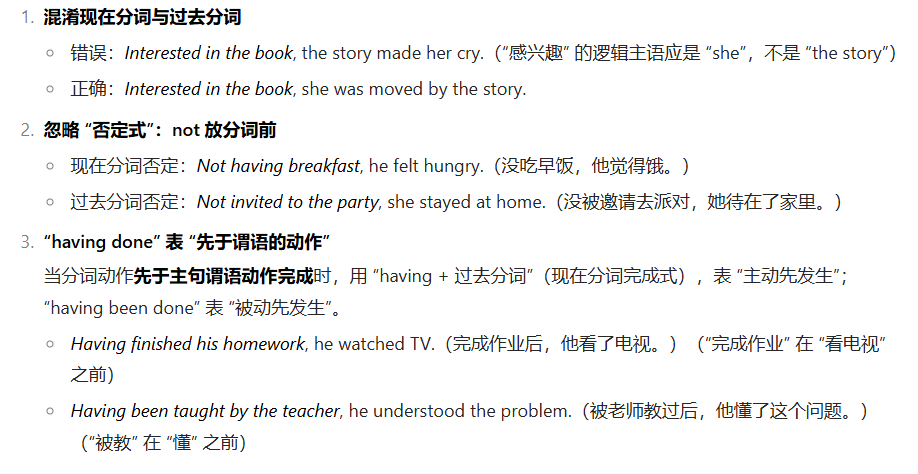
通过以上梳理,可总结为:=判断分词作状语时,先找 “逻辑主语(句子主语)”,再看 “主动 / 被动” 和 “动作先后”,最后结合语境确定逻辑关系(时间、原因等),即可准确使用。
更多推荐
 已为社区贡献29条内容
已为社区贡献29条内容


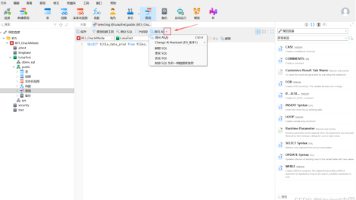






所有评论(0)